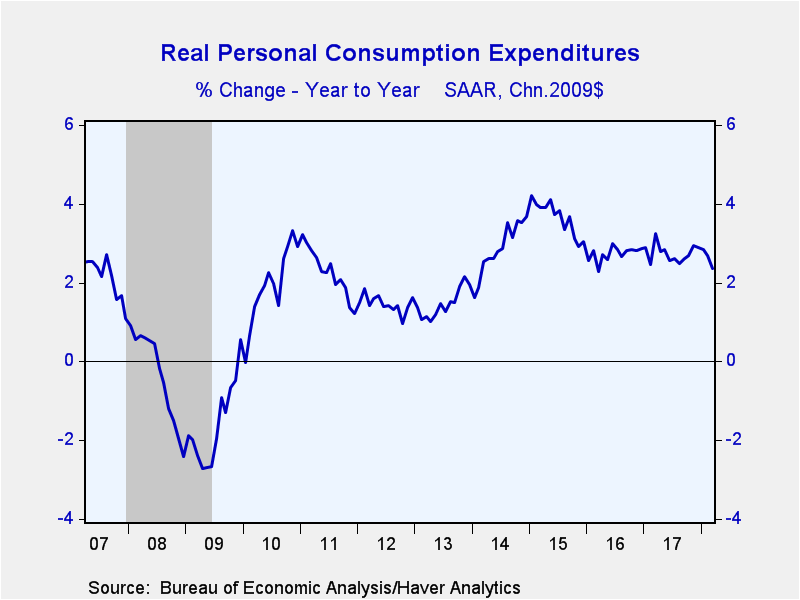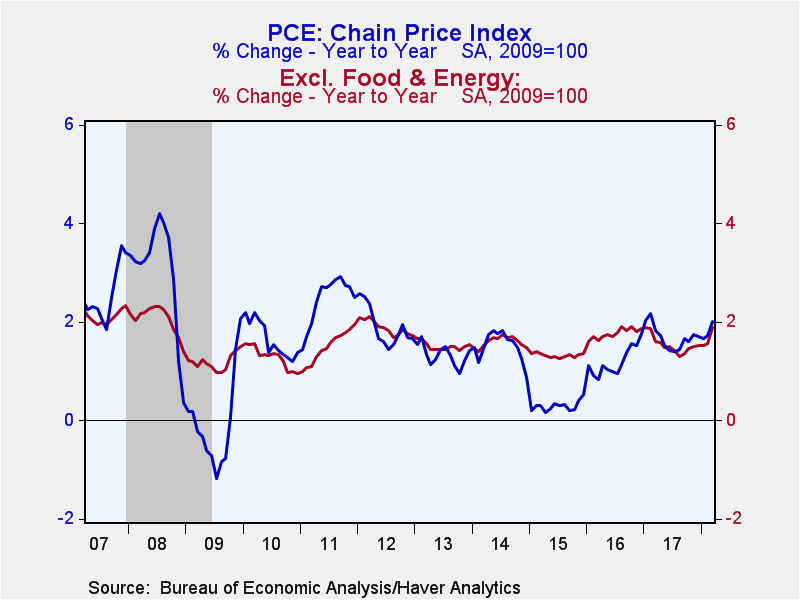 Global| Apr 30 2018
Global| Apr 30 2018U.S. Personal Spending Improves; Income Growth Is Stable
by:Tom Moeller
|in:Economy in Brief
Summary
Personal consumption expenditures in March bounced back an expected 0.4% (4.4% y/y) following stability in February. The gain matched expectations in the Action Economics Forecast Survey. Real personal spending also rose 0.4% (2.4% [...]
Personal consumption expenditures in March bounced back an expected 0.4% (4.4% y/y) following stability in February. The gain matched expectations in the Action Economics Forecast Survey. Real personal spending also rose 0.4% (2.4% y/y) as prices were stable. The increase followed declines during the prior two months. Motor vehicle spending in constant dollars strengthened 1.4% (3.7% y/y) after declines in three of the prior four months. Real home furnishings & appliance purchases rose 0.9% (7.4% y/y) after February's stability. Real spending on recreational goods & vehicles surged 1.3% (8.3% y/y) after a 2.3% rise. Real apparel purchases rose 0.9% (1.8% y/y) following declines during each of the prior three months. Real food & beverage purchases gained 0.4% (3.0% y/y) also following three months of decline. Real gasoline & fuel buying gained 0.4% (-1.2% y/y) after falling for two months. Real services purchases increased 0.3% (1.7% y/y) after a 0.1% dip. Real housing & utilities spending strengthened 0.9% (1.0% y/y) after two months of decline, while recreation services buying nudged 0.1% higher (-0.1% y/y). Real outlays on health care rose 0.3% (2.9% y/y) for the second month in three.
Personal income increased 0.3% (3.6% y/y) during March, the same as in February which was revised from 0.4%. A 0.4% increase had been expected. Wages & salaries improved 0.2% (4.4% y/y), the weakest gain in five months. Rental income increased 0.5% (3.9% y/y) following a 0.3% gain. Proprietors earnings rose 0.4% (3.1% y/y), half the prior month's rise. Earnings from dividend payments remained strong at 0.9% (4.7% y/y) after a 1.0% rise, but interest income eased 0.1% (+2.1% y/y) for the third straight month. Personal transfer payments rose 0.4% (2.8% y/y) following stability in February. Social security earnings jumped 1.0% (5.0% y/y) after a 0.3% fall. Medicare outlays improved 0.3% (2.8% y/y) following a 0.2% rise. These gains were offset by a 1.5% decline (-9.7% y/y) in unemployment insurance payments after a 2.5% drop.
Disposable personal income grew 0.3% (3.7% y/y) for the second consecutive month. Adjusted for price inflation, take-home pay rose 1.7% y/y.
As growth in outlays outpaced income growth, the personal savings rate fell to 3.1% from 3.3%. It compared to the 2.4% low three months earlier. The level of personal savings declined 17.2% y/y.
The chain price index for personal expenditures held steady after a 0.2% rise. The y/y gain nevertheless rose to 2.0%, up from 0.3% during all of 2015. Energy prices fell 2.8% (+7.9% y/y) after a 0.1% dip. Food & beverage prices rose 0.2% (0.4% y/y) after a 0.1% decline. The price index excluding food & energy rose 0.2% for the second straight month. The y/y gain of 1.9% compared to 1.3% this passed August. Durable goods pricing remained weak at -2.4% y/y, while nondurable prices rose 1.7% y/y, up from a 3.3% decline during all of 2015. Services prices strengthened 0.3% (2.8% y/y) for the second straight month. Health care prices increased 2.3% y/y, up from 0.6% in 2013. Housing & utilities prices remained strong at 3.2% y/y. Transportation services prices increased 2.4% y/y, up from 0.4% in 2015.
The personal income & consumption figures are available in Haver's USECON database with detail in the USNA database. The Action Economics figure is in the AS1REPNA database.
| Personal Income & Outlays (%) | Mar | Feb | Jan | Mar Y/Y | 2017 | 2016 | 2015 |
|---|---|---|---|---|---|---|---|
| Personal Income | 0.3 | 0.3 | 0.4 | 3.6 | 3.1 | 2.4 | 5.0 |
| Wages & Salaries | 0.2 | 0.4 | 0.5 | 4.4 | 3.3 | 2.9 | 5.1 |
| Disposable Personal Income | 0.3 | 0.3 | 0.9 | 3.7 | 2.9 | 2.6 | 4.5 |
| Personal Consumption Expenditures | 0.4 | 0.0 | 0.2 | 4.4 | 4.5 | 4.0 | 3.9 |
| Personal Saving Rate | 3.1 | 3.3 | 3.0 | 3.9 (Mar.'17) |
3.4 | 4.9 | 6.1 |
| PCE Chain Price Index | 0.0 | 0.2 | 0.4 | 2.0 | 1.7 | 1.2 | 0.3 |
| Less Food & Energy | 0.2 | 0.2 | 0.3 | 1.9 | 1.5 | 1.8 | 1.3 |
| Real Disposable Income | 0.2 | 0.1 | 0.5 | 1.7 | 1.2 | 1.4 | 4.2 |
| Real Personal Consumption Expenditures | 0.4 | -0.2 | -0.1 | 2.4 | 2.8 | 2.7 | 3.6 |
Tom Moeller
AuthorMore in Author Profile »Prior to joining Haver Analytics in 2000, Mr. Moeller worked as the Economist at Chancellor Capital Management from 1985 to 1999. There, he developed comprehensive economic forecasts and interpreted economic data for equity and fixed income portfolio managers. Also at Chancellor, Mr. Moeller worked as an equity analyst and was responsible for researching and rating companies in the economically sensitive automobile and housing industries for investment in Chancellor’s equity portfolio. Prior to joining Chancellor, Mr. Moeller was an Economist at Citibank from 1979 to 1984. He also analyzed pricing behavior in the metals industry for the Council on Wage and Price Stability in Washington, D.C. In 1999, Mr. Moeller received the award for most accurate forecast from the Forecasters' Club of New York. From 1990 to 1992 he was President of the New York Association for Business Economists. Mr. Moeller earned an M.B.A. in Finance from Fordham University, where he graduated in 1987. He holds a Bachelor of Arts in Economics from George Washington University.










